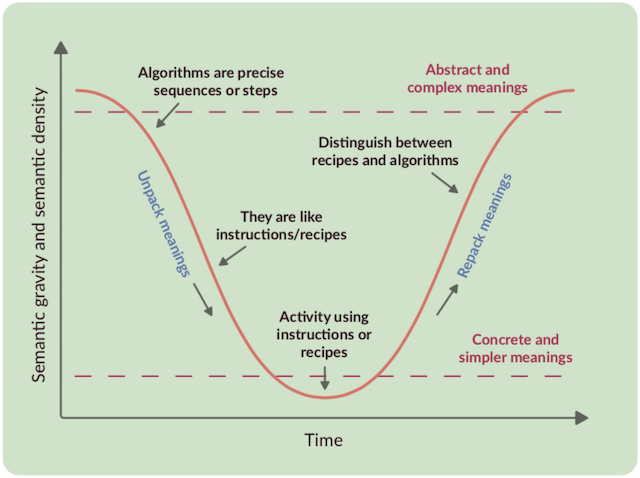Exploring computational concepts using unplugged approaches
23 June 2020

The Raspberry Pi Foundation is now running fortnightly research seminars on Tuesdays at 5pm (BST). Previous topics have included:
- Online learning with Lauren Marguilleux
- AI in School with Juan David Roderiguez
- Programming and Mathematics with Dame Celia Hoyles
All the presentations and recordings are available at http://rpf.io/research-seminars
For the fourth seminar, we were looking at learning computing “unplugged” - in other words, without using a computer. This approach is a popular way of making topics real for students, and can include analogies, similes, metaphors, role play, games, puzzles, magic tricks, and storytelling.
To bring this topic to life, we were delighted to welcome Jane Waite from Queen Mary University of London who has many years of experience in computing education, Jane with Professor Paul Curzon, also at Queen Mary University of London are currently researching how a theoretical approach known as semantic waves can be used to help us structure teaching in an unplugged way.

There are many examples of unplugged activities. Children can learn to follow or debug an algorithm in the playground by following sequences of walking instructions. I’ve seen some excellent examples of explaining the way a network works using bits of string, envelopes, laundry pegs etc. In our session, Jane used the example of drawing a character on a piece of paper, and how to help children write an accurate algorithm for their character.
So what are the benefits of unplugged activities when learning computing? It seems there are many: they can make abstract concepts concrete, they can provide physical enactment or embodiment of the concept, they can be done in groups, and quite obviously, you don’t need computing equipment to do them!
Packing and Unpacking
The example discussed in the seminar was around writing precise algorithms and how to teach this to very young children. Using an unplugged method to teach this seems a good idea. Children can be introduced to it by “drawing with instructions” rather than being taught the word “algorithm” and what it means. In this way, an accessible context is added to the concept being taught (semantic gravity) and the complexity of the concept is reduced by using everyday language to simplify the vocabulary (semantic density). An algorithm is a difficult and abstract concept to understand without this kind of support, whereas following instruction to drawing a funny character is a familiar activity for young learners.
By using everyday language, or an accessible context, an abstract concept, such as an algorithm, can be “unpacked” to something understandable. However stopping at that point won’t help the learning. All children will have learned is that they have drawn something. “Repacking” is important too - going back to the concept and re-introducing the technical language. This can be done by the teacher verbally, or by moving from unplugged back to a “plugged-in” activity, gradually removing the contextual example.
Semantic Waves
Semantic density and semantic gravity are concepts relating to semantic waves, a key element of a theoretical framework for understanding concepts known as legitimation code theory. Legitimation code theory was introduced in 2000 by Karl Maton, of the University of Sydney, Australia. It’s been applied in many subjects but Jane and her group of colleagues are the first to use this for computer science in primary classrooms.
Jane gave us an example of the way a teacher could reflect on their lesson by drawing a semantic wave to check that they were unpacking and repacking the concept being taught. We can probably all recall a teaching experience of our own when we’ve been taught something that was never contextualised or full of technical terms and we really struggled to understand it, so this is a very useful strategy.
Unplugged activities can offer a great opportunity to teach computing concepts when there aren’t enough computers available, and as such can be very useful in more economically-challenged areas. The approach described here should help to ensure that computing concepts being taught are not lost in the midst of a fun activity. There are dozens of different unplugged activities to try at https://teachinglondoncomputing.org/ and at http://www.cs4fn.org/. We’ve also produced a Pedagogy Quick Read about Semantic Waves as part of our work with the National Centre for Computing Education. You can also read Jane’s original paper “Unplugged Computing and Semantic Waves: Analysing Crazy Characters”.
Next up in our series
If you missed the seminar, you can find Jane’s presentation slides and a recording of her talk on our seminars page.
In our next seminar on Tuesday 30 June at 17:00–18:00 BST / 12:00–13:00 EDT / 9:00–10:00 PDT / 18:00–19:00 CEST, we’ll welcome Dr Briana Morrison, Assistant Professor, Information Science and Technology, University of Nebraska-Omaha. Briana will be sharing some insights into reducing cognitive load when teaching programming through an approach known as sub-goal labelling. To join the seminar, simply sign up with your name and email address and we’ll email you the link and instructions. If you attended Jane’s seminar, the link remains the same.